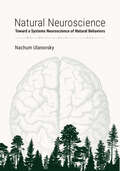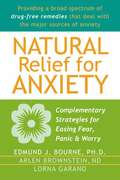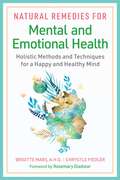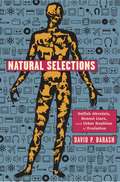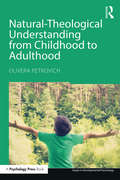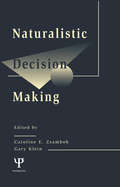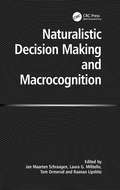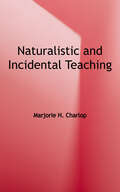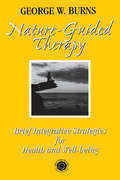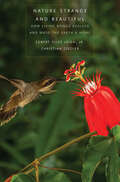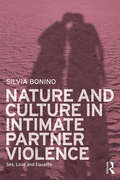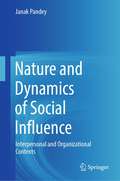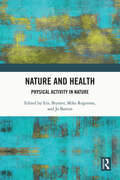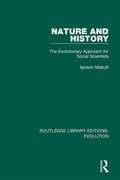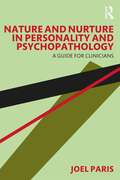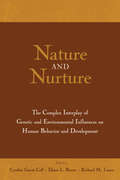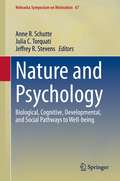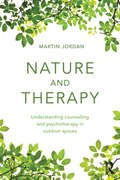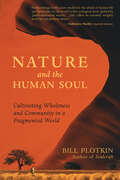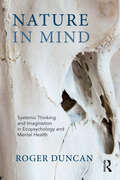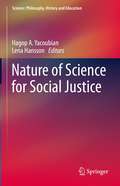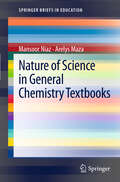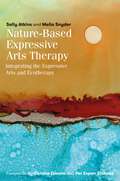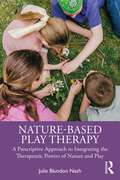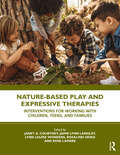- Table View
- List View
Natural Neuroscience: Toward a Systems Neuroscience of Natural Behaviors
by Nachum UlanovskyA new approach to brain research that emphasizes studying the brain under naturalistic conditions.Natural neuroscience departs from the classical reductionist approach, which emphasizes control at the expense of natural behaviors, by proposing a shift toward real-world relevance, natural behaviors, and ecological validity. In Natural Neuroscience, Nachum Ulanovsky presents the conceptual, empirical, and technological underpinnings that enabled this new field. Natural neuroscience researchers posit that when studying any brain region in any animal, whether standard mammalian species such as rodents and primates or nonstandard species, it is crucial to pursue the animal&’s natural behaviors and to consider the natural problems it needs to solve. By preventing rich natural behaviors, says Ulanovsky, we miss key aspects of brain function—and we may not even know what we miss.The author surveys recent studies that have begun to move in this direction across multiple subfields of neuroscience, including sensory, cognitive, social, and behavioral neuroscience. He discusses technological advances that are allowing the pursuit of more naturalistic experiments, including methods for recording neural activity in freely behaving, freely moving animals (e.g., wired and wireless electrophysiology and imaging); methods for manipulating neural activity in freely moving animals (e.g., wired and wireless optogenetics); and methods for quantifying the details of behavior. He makes connections across the four major scientific disciplines that focus on understanding behavior—neuroscience, behavioral ecology, ethology, and psychology—bringing them closer together, and closer to real life.
Natural Relief for Anxiety: Complimentary Strategies for Easing Fear, Panic, and Worry
by Lorna Garano Edmund J. Bourne Arlen BrownsteinBack Cover: "Twenty-five million Americans suffer from diagnosable anxiety disorders, and millions more struggle with occasional feelings of fear, panic, and worry. Pharmaceutical companies spend billions each year developing drugs to counteract these feelings, but the truth is that there is no "magic pill" that can make anxiety go away. Anxiety treatments that rely on medication have a high incidence of relapse when the medication stops. And the side effects of these drugs can be more debilitating than the condition they were designed to treat. An alternative and more lasting way to control anxiety is to make gentle, natural changes to your lifestyle that promote wellness in mind and body. Written by the best-selling author of The Anxiety and Phobia Workbook and a naturopathic physician, this book offers you a complete strategy for overcoming anxiety without drugs. Begin by taking a look at the choices you make every day about your lifestyle and general well-being. Calm your anxious mind with healthy self-talk. Learn the importance of exercise and a healthy, natural diet in controlling anxiety. Discover techniques that promote deep physical relaxation. Find out which nutritional supplements and natural therapies can help you on your way to renewed peace of mind. Explore ways you can simplify your life to reduce stress. The book offers a broad range of self-care resources as well as information about how and when to seek outside help. Complementary treatment approaches: * Relaxation, exercise, and diet improvement * Herbs and nutritional supplements * Massage and bodywork * Chiropractic care * Mindfulness meditation, yoga, and t'ai chi * Homeopathic and naturopathic medicine," and spirituality.
Natural Remedies for Mental and Emotional Health: Holistic Methods and Techniques for a Happy and Healthy Mind
by Chrystle Fiedler Brigitte MarsA self-care guide to treating mental, emotional, and neurological conditions• Explores common mental health concerns and stress-related issues—such as anxiety, depression, anger, insomnia, brain fog, and trauma—and shares remedies and practices to address and heal their root causes • Examines the influence of diet and nutrition on mental health and the benefits of specific foods, herbs, supplements, essential oils, and self-care techniques • Details holistic remedies for neurological conditions, such as ADHD, epilepsy, addiction, bipolar disorder, PTSD, multiple sclerosis, Parkinson&’s disease, traumatic brain injury (TBI), and stroke Mental health and emotional well-being are just as important as physical health. And like physical health, there are many simple ways to improve and support mental wellness with the healing power of herbs and other holistic remedies and practices. In this comprehensive guide to natural methods to maintain a healthy mind, herbalist Brigitte Mars and natural health expert Chrystle Fiedler explore many common mental health concerns and stress-related issues—such as anxiety, depression, panic attacks, anger, insomnia, brain fog, and trauma—and share remedies and practices to address and heal their root causes. Citing recent medical studies, they examine the influence of diet and nutrition on mental health concerns and explore the benefits of specific foods, herbs, supplements, essential oils, and self-care techniques like acupressure, massage, and color therapy. The authors also explore holistic practices and treatments for moving through grief, breaking free from addiction, working with ADHD and epilepsy, supporting chronic conditions like bipolar disorder, PTSD, and Parkinson&’s disease, and recovering from traumatic brain injury (TBI) and stroke. Presenting a wealth of holistic self-care therapies for mental well-being, emotional balance, and neurological health, this guide enables each of us to heal the mind and nurture the soul, two essential keys to a happy, joyful life.
Natural Selections
by David P. Barash"Barash . . . brilliantly integrat[es] science, literature, and pop culture into elegant and insightful commentaries on the most interesting and important questions of our time. A delightful read."--Michael Shermer, author of The Science of Good and Evil "Entertaining and thought-provoking."--Steven Pinker, author of The Blank Slate If we are, in part, a product of our genes, can free will exist? Incisive and engaging, this indispensable tour of evolutionary biology runs the gamut of contemporary debates, from science and religion to our place in the universe.
Natural-Theological Understanding from Childhood to Adulthood (Essays in Developmental Psychology)
by Olivera PetrovichIt is commonly assumed that young children only begin to think about God as a result of some educational or cultural influence, perhaps provided by their parents. Natural-Theological Understanding from Childhood to Adulthood asks if there is anything about God that children can know independently of any specific cultural input; does their knowledge of God simply come from their everyday encounters with the surrounding world? Whilst children’s theoretical reasoning in biology, physics and psychology has received considerable attention in recent developmental research, the same could not be said about their religious or theological understanding. Olivera Petrovich explores children’s religious concepts, from a natural-theological perspective. Using supporting evidence from a series of studies with children and adults living in as diverse cultures as the UK and Japan, Petrovich explains how young children begin to construct their everyday scientific and metaphysical theories by relying on their own already advanced causal understanding. The unique contribution that this volume makes to the developmental psychology of religion is its contention that religion or theology constitutes one of the core domains of human cognition rather than being a by-product of other core domains and specific cultural inputs. Natural-Theological Understanding from Childhood to Adulthood is essential reading for students and researchers in cognitive-developmental psychology, religious studies, education and cognitive anthropology.
Naturalistic Decision Making (Expertise: Research and Applications Series)
by Gary Klein Caroline E. ZsambokIf you aren't using the term naturalistic decision making, or NDM, you soon will be. Even as a very young field, NDM has already had far-reaching applications in areas as diverse as management, aviation, health care, nuclear power, military command and control, corporate teamwork, and manufacturing. Put simply, NDM is the way people use their experience to make decisions in the context of a job or task. Of particular interest to NDM researchers are the effects of high-stake consequences, shifting goals, incomplete information, time pressure, uncertainty, and other conditions that are present in most of today's work places and that add to the complexity of decision making. Applications of NDM research findings target decision aids and training that help people in their decision-making processes. This book reports the findings of top NDM researchers, as well as many of their current applications. In addition, the book offers a historical perspective on the emergence of this new paradigm, describes recent theoretical and methodological advancements, and points to future developments. It was written for people interested in decision making research and applications relative to a diverse array of work settings and products such as human-computer interfaces, decision support systems, individual and team training, product designs, and organizational development and planning.
Naturalistic Decision Making and Macrocognition
by Jan Maarten SchraagenThis book presents the latest work in the area of naturalistic decision making (NDM) and its extension into the area of macrocognition. It contains 18 chapters relating research centered on the study of expertise in naturalistic settings, written by international experts in NDM and cognitive systems engineering. The objective of the book is to present the reader with exciting new developments in this field of research, which is characterized by its application-oriented focus. The work addresses only real-world problems and issues. For instance, how do multi-national teams collaborate effectively? How can surgeons best be supported by technology? How do detectives make sense of complex criminal cases? In all instances the studies have been carried out on experts within their respective domains. The traditional field of NDM is extended in this work by focusing on macrocognitive functions other than decision making, namely sense-making, coordination and planning. This has broadened the scope of the field. The book also contains a theoretical discussion of the macro-micro distinction. Naturalistic Decision Making and Macrocognition will be relevant to graduate students, researchers and professionals (including professionals and researchers in business, industry and government) who are interested in decision making, expertise, training methods and system design. The material may be used in two ways: theoretically, to advance understanding of the field of naturalistic decision making; and practically, to gain insight into how experts in various domains solve particular problems, understand and deal with issues and collaborate with others.
Naturalistic and Incidental Teaching
by Marjorie H. CharlopNaturalistic teaching strategies (NaTS) are evidence-based interventions, rooted in applied behavior analysis, that are carried out in loosely structured environments, such as play settings, home settings, or community settings, that are more akin to what occurs in the natural environment. They have similar philosophical approaches, similar treatment components, and thus similar treatment outcomes. NaTS are considered naturalistic not only because of the setting but also because of the manner of delivery. Behavior change agents often come from nontherapeutic environments, such as parents or teachers, or even peers and siblings. NaTS are well suited to teaching behaviors that tend to occur in the natural environment, such as those pertaining to communication and social skills. NaTS often utilize or mimic a typical daily setting.
Nature Guided Therapy: Brief Integrative Strategies For Health And Well Being
by George W. BurnsBeginning with an evolutionary history of the relationship between man and his environment, Nature-Guided Therapy takes us on a cross-cultural journey into traditional healing disciplines, such as ethno-medicine, sociobiology, and anthropology. By examining clinical data, empirical scientific investigations, and anecdotal accounts, Dr. George Burns helps point the way to healing benefits of a balanced relationship with the environment. Case histories and step by step procedures for utilizing nature-guided strategies are also presented. Designed as an immensely practical guide for clinicians, this volume contains over 80 therapeutic exercises and a variety of nature-based strategies to help augment clinical skills regardless of one's theoretical orientation. Also included is the author's Sensual Awareness Inventory to help access the client's experiences that may facilitate relaxation, happiness, and wellness. This book provides a fascinating read that can expand our views, challenge our therapeutic paradigms, broaden our clinical practice, and provide simple yet pragmatic treatment interventions.
Nature Strange and Beautiful: How Living Beings Evolved and Made the Earth a Home
by Christian Ziegler Egbert Giles LeighA beautifully written exploration of how cooperation shaped life on earth, from its single-celled beginnings to complex human societiesIn this rich, wide-ranging, beautifully illustrated volume, Egbert Leigh explores the results of billions of years of evolution at work. Leigh, who has spent five decades on Panama&’s Barro Colorado Island reflecting on the organization of various amazingly diverse tropical ecosystems, now shows how selection on &“selfish genes&” gives rise to complex modes of cooperation and interdependence.With the help of such artists as the celebrated nature photographer Christian Ziegler, natural history illustrator Deborah Miriam Kaspari, and Damond Kyllo, Leigh explains basic concepts of evolutionary biology, ranging from life&’s single-celled beginnings to the complex societies humans have formed today. The book covers a range of topics, focusing on adaptation, competition, mutualism, heredity, natural selection, sexual selection, genetics, and language. Leigh&’s reflections on evolution, competition, and cooperation show how the natural world becomes even more beautiful when viewed in the light of evolution.
Nature and Culture in Intimate Partner Violence: Sex, Love and Equality
by Silvia BoninoThis innovative book aims to further our understanding of violence in intimate relationships between men and women by combining research from psychology, cultural studies, and biology. The author examines why western culture often justifies and encourages primitive forms of relationships based on domination and submission and considers not only the cultural influences, but also the biological aspects, in their interaction. The book clarifies the biological roots of aggression and affection in intimate relationships in humans, showing that considering the biological roots of male dominance on women does not imply any justification. Bonino makes the case that awareness about the biological roots of violence, and about the cultural messages supporting them, is necessary for developing different messages and educational practices promoting human capacity of personal affective relationship, where partners empathically recognize themselves as equal human beings. Relationships are examined in relation to a domination/submission framework, with the author emphasizing the role individuals can play in promoting non-aggressive relationships. By examining aggressive behaviour in relation to cultural, social psychological, and biological ideas, the author seeks to clarify the cause of violence in relation to gendered roles. This is fascinating reading for anyone interested in violence in relationships and suitable for students and academics in psychology and the social sciences.
Nature and Dynamics of Social Influence: Interpersonal and Organizational Contexts
by Janak PandeyThe book presents the various ways in which persuasion can be used to make people behave in certain ways without coercion, intimidation, or brute force. It explores the intricacies of social influence processes like self-presentation, impression management, ingratiation, persuasion, manipulative social behavior, and compliance in socio-cultural contexts. Social influence constitutes one of the key themes in the field of social psychology. Contributions in the book highlight social influence behavior and its importance in human social life. The book deepens the reader's understanding of social psychology research on the science and applications of social influence. It invites readers to consider critical questions, such as the interactive effects of personality/disposition and situational factors on social influence. Given its scope, the book is of interest to those in academic fields like social psychology, political science, mass communication, and marketing.
Nature and Health: Physical Activity in Nature (Routledge Research in Health, Nature and the Environment)
by Eric Brymer Jo Barton Mike RogersonExperiences in nature are now recognised as being fundamental to human health and well-being. Physical activity in nature has been posited as an important well-being facilitator because the presence of nature augments the benefits of physical activity while also enhancing motivation and adherence. This volume brings together a mix of cutting edge ideas in research, theory and practice from a wide set of disciplines with the purpose of exploring interdisciplinary or trans-disciplinary approaches to understanding the relationship between physical activity in nature and health and well-being. Nature and Health: Physical Activity in Nature is structured to facilitate ease of use for the researcher, policy maker, practitioner or theorist. Section 1 covers research on physical activity in nature for a number of important health and well-being issues. Each chapter in this section considers how policy and practice might be shaped by current research findings and knowledge. Section 2 considers contemporary theoretical and conceptual understandings that help explain how physical activity in nature enhances health and well-being and also how best to design interventions and research. Section 3 provides examples of current approaches. This book is an ideal resource for both researchers and advanced students interested in designing future-proofed research, for policy makers interested in improving community well-being and for practitioners interested in best practice applications.
Nature and History: The Evolutionary Approach for Social Scientists (Routledge Library Editions: Evolution #6)
by Ignazio MasulliOriginally published in 1990, Nature and History examines how Darwin’s theory of evolution has been expanded by scholars and researchers to include virtually every scientific discipline. The book presents a morphological analysis of historical and social sciences – sciences which have traditionally have been viewed as too random in their progressions to conform to a model. Through the evaluation of empirical and factual evidence, the book builds a case for an evolutionary paradigm which encompasses both natural and social sciences, and presents the form’s adaptiveness in working historical models.
Nature and Nurture in Personality and Psychopathology: A Guide for Clinicians
by Joel ParisPsychiatry and clinical psychology have long been divided about the roles of nature and nurture in the pathways to psychopathology. Some clinicians offer treatment almost entirely based on neuroscience. Some psychologists offer psychotherapies almost entirely based on the impact of environmental stressors. Paris argues for a balanced middle ground between nature and nurture in human development. This book reviews and integrates research showing that the key to understanding the development of mental disorders lies in interactions between genes and environment. It explores why personality is a key determinant of how people respond to stress, functioning as a kind of psychological immune system. This model represents a shift from overly simple and reductionistic constructs, based primarily on biological risks or on psychosocial risks in development. Instead, it offers a complex and multivariate approach that encourages a broader approach to treatment. This book is essential for all mental health clinicians who are interested in understanding the roles of nature and nurture in the development of psychopathology.
Nature and Nurture: The Complex Interplay of Genetic and Environmental Influences on Human Behavior and Development
by Richard M. Lerner Cynthia García Coll Elaine L. BearerWhat does it mean to find a gene or set of genes that are associated with ADHD, schizophrenia, or autism? Could we eradicate such diseases from our species through gene therapy? Is it possible to eradicate from our genome the genetic material that predisposes us to be too aggressive, too shy, less intelligent, or not active enough? Who has the political power and/or moral authority to make these decisions? The premise of Nature and Nurture is that the complexity of the transactions between nature and nurture--between genes and the environment from the cellular to the cultural level--make these questions incredibly complex and in need of careful attention by educators, scientists, the public, and policymakers. A product of the conference held at Brown University in 2001, this book suggests that genes and environments work together interactively in a complex and closely intertwined fashion. The contributors to this book--biologists, psychologists, psychiatrists, and economists--present knowledge that enables research and application to transcend the traditional question of whatever variance or significance is attributed to genetics versus environment in the development of a particular behavioral trait. This book presents a variety of views on the current status of knowledge about the ways in which dynamic, developmental, mutually interactive systems in the genetic and environmental domains operate. The chapters represent contributions from different perspectives.
Nature and Psychology: Biological, Cognitive, Developmental, and Social Pathways to Well-being (Nebraska Symposium on Motivation #67)
by Jeffrey R. Stevens Anne R. Schutte Julia C. TorquatiThis volume is comprised of contributions to the 67th Nebraska Symposium on Motivation, which brought together various research disciplines such as psychology, education, health sciences, natural resources, environmental studies to investigate the ways in which nature influences cognition, health, human behavior, and well-being. The symposium is positioned to explore two proposed mechanisms in the most depth: 1) the psycho-evolutionary theory of stress recovery and 2) Attention Restoration Theory. The contributions in the volume represent research guided by both of these posited mechanisms, rigorously examine these theories and processes, and share methodological innovations that can be utilized across programs of research. This volume will be of great interest to researchers on natural environments, practitioners and clinicians working with an environmental lens at the intersection of psychology, social work, education and the health sciences, as well as researchers and students in environmental and conservation psychology. Chapter 5 is available open access under a Creative Commons Attribution 4.0 International License via link.springer.com.
Nature and Therapy: Understanding Counselling and Psychotherapy in Outdoor Spaces
by Martin JordanRecent decades have seen an increasing interest in the healing and therapeutic potential of nature and interest in the potential of greencare interventions for the benefit of mental health. The field of nature based therapies is expanding in line with this interest. Nature and Therapy offers a unique contribution by outlining the specific processes involved in conducting counselling and psychotherapy sessions in outdoor natural environments. Central areas covered in the book include: A thorough exploration of the evidence for the psychological and healing potential of natural spaces; Developing a therapeutic rationale for nature based therapeutic work; Understanding the therapeutic relationship and the unique therapeutic processes that come into play in outdoor natural spaces; Translating indoor therapeutic work to outdoor contexts; The practicalities of setting up and running a therapy session outside of a room environment; and experiential exercises to explore the therapeutic potential of nature.
Nature and the Human Soul: Cultivating Wholeness and Community in a Fragmented World
by Bill PlotkinAddressing the pervasive longing for meaning and fulfillment in this time of crisis, Nature and the Human Soul introduces a visionary ecopsychology of human development that reveals how fully and creatively we can mature when soul and wild nature guide us. Depth psychologist and wilderness guide Bill Plotkin presents a model for a human life span rooted in the cycles and qualities of the natural world, a blueprint for individual development that ultimately yields a strategy for cultural transformation. If it is true, as Plotkin and others observe, that we live in a culture dominated by adolescent habits and desires, then the enduring societal changes we so desperately need won’t happen until we individually and collectively evolve into an engaged, authentic adulthood. With evocative language and personal stories, including those of elders Thomas Berry and Joanna Macy, this book defines eight stages of human life — Innocent, Explorer, Thespian, Wanderer, Soul Apprentice, Artisan, Master, and Sage — and describes the challenges and benefits of each. Plotkin offers a way of progressing from our current egocentric, aggressively competitive, consumer society to an ecocentric, soul-based one that is sustainable, cooperative, and compassionate. At once a primer on human development and a manifesto for change, Nature and the Human Soul fashions a template for a more mature, fulfilling, and purposeful life — and a better world.
Nature in Mind: Systemic Thinking and Imagination in Ecopsychology and Mental Health
by Roger DuncanNature in Mind explores a kind of madness at the core of the developed world that has separated the growth of human cultural systems from the destruction of the environment on which these systems depend. It is now becoming increasingly clear that the contemporary Western lifestyle not only has a negative impact on the ecosystems of the earth but also has a detrimental effect on human health and psychological wellbeing. The book compares the work of Gregory Bateson and Henry Corbin and shows how an understanding of the "imaginal world" within the practice of systemic psychotherapy and ecopsychology could provide a language shared by both nature and mind. This book argues the case for bringing nature-based work into mainstream education and therapy practice. It is an invitation to radically reimagine the relationship between humans and nature and provides a practical and epistemological guide to reconnecting human thinking with the ecosystems of the earth.
Nature of Science for Social Justice (Science: Philosophy, History and Education)
by Hagop A. Yacoubian Lena HanssonThis edited volume brings closer two contemporary science education research areas: Nature of Science (NOS) and Social Justice (SJ). It starts a dialogue on the characteristics of NOS for SJ with the purpose of advancing the existing discussion and creating new avenues for research. Using a variety of approaches and perspectives, the authors of the different chapters engage in a dialogue on the construct of NOS for SJ, its characteristics, as well as ways of addressing it in science classrooms. Issues addressed are related to why a school science aiming at SJ should address NOS; what NOS-related content, skills and attitudes form the basis when aiming at SJ; and how school science can address NOS for SJ. Through a set of theoretical and empirical chapters, the authors suggest answers, but they also pose new questions on what NOS for SJ can mean, and what issues need to be taken into consideration in future research and practice.
Nature of Science in General Chemistry Textbooks
by Arelys Maza Mansoor NiazResearch in science education has recognized the importance of history and philosophy of science (HPS). Nature of science (NOS) is considered to be an essential part of HPS with important implications for teaching science. The role played by textbooks in developing students' informed conceptions of NOS has been a source of considerable interest for science educators. In some parts of the world, textbooks become the curriculum and determine to a great extent what is taught and learned in the classroom. Given this background and interest, this monograph has evaluated NOS in university level general chemistry textbooks published in U.S.A. Most textbooks in this study provided little insight with respect to the nine criteria used for evaluating NOS. Some of the textbooks, however, inevitably refer to HPS and thus provide guidelines for future textbooks. A few of the textbooks go into considerable detail to present the atomic models of Dalton, Thomson, Rutherford, Bohr and wave mechanical to illustrate the tentative nature of scientific theories --- an important NOS aspect. These results lead to the question: Are we teaching science as practiced by scientists? An answer to this question can help us to understand the importance of NOS, by providing students an HPS-based environment, so that they too (just like the scientists) feel the thrill and excitement of discovering new things. This monograph provides students and teachers guidelines for introducing various aspects of NOS, based on historical episodes.
Nature-Based Expressive Arts Therapy: Integrating the Expressive Arts and Ecotherapy
by Per Espen Stoknes Sally Atkins Corrine Glesne Melia SnyderResponding to the increased interest in the integration of expressive arts and ecotherapy, this book presents a nature based approach to expressive arts work. It provides an overview of the two fields, emphasizing how they can enrich and learn from each other, and highlights attitudes and practices in expressive arts that are particularly relevant to working with nature. This includes cultivating an aesthetic response to the earth, the relationship between beauty and sustainability, and lessons about art and nature from indigenous cultures. Four suggested structures for a nature based expressive arts activity - including writing, body, and ritual centered - are provided in the appendices.
Nature-Based Play Therapy: A Prescriptive Approach to Integrating the Therapeutic Powers of Nature and Play
by Julie Blundon NashNature-Based Play Therapy brings a theoretical basis to arguments for including nature in play therapy and provides tools for that inclusion with a prescriptive model. Throughout this book, play therapists are introduced to the histories of nature and play across cultures and cultural expectations and are then guided into an understanding of how nature and play intersect with current trends in society and psychotherapy. Readers will learn about how the therapeutic powers of play are activated and facilitated by the inclusion of nature in play therapy, and they will be taken step-by-step through a prescriptive case conceptualization model. They’ll also find case studies that link theoretical tenets, the therapeutic powers and play and nature, and intended treatment outcomes. Nature-Based Play Therapy is an excellent introduction to a vital and growing area of the field, one that gives a well-rounded summary to a theoretically based model of treatment.
Nature-Based Play and Expressive Therapies: Interventions for Working with Children, Teens, and Families
by Janet A. CourtneyNature-Based Play and Expressive Therapies addresses a wide range of healing modalities and case studies that can be used in both indoor and outdoor environments. Each chapter includes vignettes to support the interventions and approaches presented. Readers will find a diverse array of helpful handouts and topics explored, including tips for creating outdoor healing gardens and labyrinths, guidelines for using nature to address trauma, working with sandplay and storytelling in nature, adapting nature-based interventions via telehealth, and much more. Chapters focus on work with young children and teens in individual settings as well as work with families and groups, making this book an important read for a wide range of mental health professionals.
